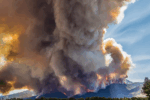Southern Indiana – From the subtle color bands on woolly bear worms to the toughness of onions, nature has been offering clues about the approaching winter for generations of Hoosiers. Whether you are a believer in age-old weather lore or a skeptic, these natural signs remain a fascinating and sometimes surprisingly accurate way to anticipate colder months.
Exploring these traditional weather predictors offers a unique glimpse into the wisdom passed down through Indiana’s farming communities and weather watchers. While modern meteorology relies on satellites and advanced models, many local residents still keep an eye on these natural indicators every fall.
Woolly Bear Worms: Fuzzy Forecasters of Winter
Among the most iconic and beloved signs of winter prediction in Indiana are the woolly bear worms, or woolly bear caterpillars. According to folklore and sources like the Farmer’s Almanac, the width of their rusty-brown bands versus black fur supposedly indicates the severity of the coming winter:
- Wide rusty-brown band means a milder winter
- More black fur suggests a harsher winter
- Other colors (white, yellow) usually indicate it’s not a true woolly worm and shouldn’t be counted
While scientific studies have not conclusively proven these claims due to limited research, the woolly worm remains a cherished part of Indiana’s fall traditions.
“The colors on woolly bear worms have been a fun tradition for Hoosiers, though science hasn’t fully backed the predictions,” says a local nature enthusiast.
Signs from Tough Onions, Apples, and Corn
Farmers and gardeners in Indiana also swear by the physical characteristics of fruits and vegetables as natural weather barometers. The belief is that when an onion feels tough to cut, an apple bites hard, or corn is difficult to shuck, nature is preparing for a difficult winter.
- These tougher textures are thought to be a form of natural protection plants develop ahead of harsh weather.
- It reflects the idea that plants ‘armor up’ in anticipation of cold conditions.
Though subjective, this method adds practical observation to weather prediction, connecting daily farming experiences with seasonal changes.
Spiderwebs as an Unexpected Frost Warning
Another lesser-known indicator comes from the behavior of spiders. In Southern Indiana, locals watch for large, thick spiderwebs appearing in the fall, which often presage frost and bitter cold.
Thick webs signal spiders are preparing themselves for colder weather, and their sudden abundance can be a natural alert for residents to ready their homes and wardrobes.
Additional Hoosier Weather Folklore
Indiana’s residents also embrace a rich tapestry of quirky weather predictions, with many connected to the behavior of animals or atmospheric conditions. Some popular examples include:
- Early August fog foretells early snowfall in winter.
- Thicker-than-usual squirrel tails anticipate cold, snowy days.
- If the first snow sticks around for three days, it may signify a long snowy season.
- “If crows fly low, winds going to blow; if crows fly high, winds going to die.”
- “Clear moon, frost soon.”
- “Onionskin is very thin, mild winter is coming in. Onionskin is thick and tough winter will be cold and rough.”
These sayings, gathered over generations and referenced from sources like Weather Wiz Kids, represent the rich cultural heritage connected to Indiana’s climate.
Bridging Folklore and Modern Weather Science
While folklore offers entertaining and sometimes effective signs of changing seasons, modern meteorological data remains essential for precise forecasts. Organizations like the National Weather Service provide updated insights and weather safety information, especially for severe conditions such as wildfires.
For example, the National Weather Service’s guidance on wildfire safety complements the traditional observations, helping residents stay informed and prepared year-round.
Why These Natural Signs Still Matter Today
Even in an age dominated by technology, many Indiana residents find value in these natural signals for several reasons:
- Cultural connection: They tie families and communities to the land and each other.
- Practical observation: Local environmental cues can sometimes indicate changes ahead missed by broader-scale forecasts.
- Engagement with nature: Encouraging outdoor activity and curiosity about the environment.
Whether it’s spotting a woolly worm or feeling the toughness of an onion, these traditions keep a special part of Indiana’s heritage alive.
What Do You Think About These Winter Weather Signs?
Have you ever noticed these natural indicators around Indiana? Do you trust the woolly bear worm or the tough onion over the weather report? Share your experiences and thoughts in the comments below!
For more fascinating insights about Indiana’s nature signs and weather folklore, visit the original report on News Break.







